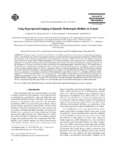Using Hyperspectral Imaging to Quantify Phototrophic Biofilms on Granite

Not available until 9999-99-99
View/
Use this link to cite
http://hdl.handle.net/2183/35540Collections
- Investigación (EPEF) [590]
Metadata
Show full item recordTitle
Using Hyperspectral Imaging to Quantify Phototrophic Biofilms on GraniteAuthor(s)
Date
2020-03Citation
Ramil, A., Vázquez-Nion, D., Pozo-Antonio, J., Sanmartín, P., Prieto, B. Using Hyperspectral Imaging to Quantify Phototrophic Biofilms on Granite. JOURNAL OF ENVIRONMENTAL INFORMATICS, 2018, vol. 35, no. 1 Disponible en: http://www.jeionline.org/index.php?journal=mys&page=article&op=view&path%5B%5D=201800401.
Abstract
[Abstract]: This paper reports a non-invasive method for in situ biofilm quantification based on the use of hyperspectral imaging to analyze a chromatically and texturally heterogeneous substrate as granite colonized by green algae and cyanobacteria. Biofilm-forming microorganisms were inoculated on granite blocks and incubated under laboratory conditions for 21 days. The intensity of the green stains formed on the granite surfaces differed depending on the initial concentration of microorganisms used. A biofilm quantification (BQ) index was computed to determine the level of colonization on the surfaces. The index was obtained by comparing the quotient of the reflectance of the green (G) and red (R) bands of each pixel of the hyperimage against a threshold value, fth. The optimal value of the threshold was determined by examining the linear correlation between the BQ index and the chlorophyll a extracted. The BQ results were then compared with the F0 and ΔE*ab parameters yielded by colour spectrophotometry and PAM fluorometry techniques and used as reference methodologies to quantify greening on stone surfaces. The BQ index showed a high level of consistency with all of the other parameters; it was linearly correlated with the chlorophyll a concentration, F0 andΔE*ab, with high coefficients of determination (r2 > 0.92) for the range from 1.87 to 5.69 μg chl a.cm-2. The strength of the BQ index lies in its double use as a biomarker of quantity and percentage cover, as well as its good performance under different conditions, ranging from initial phototrophic colonization and thin (young) biofilms covering 21.19% of the surface to profuse biological colonization covering 67.36% of the surface. Moreover, the proposed BQ index may be able to be used with other types of rock with less heterogeneous surfaces than granite.
Keywords
Biofilms
Chlorophyll fluorescence
Colour spectrophotometry
Hyperspectral imaging
Non-invasive technique
Chlorophyll fluorescence
Colour spectrophotometry
Hyperspectral imaging
Non-invasive technique
Editor version
ISSN
1726-2135





